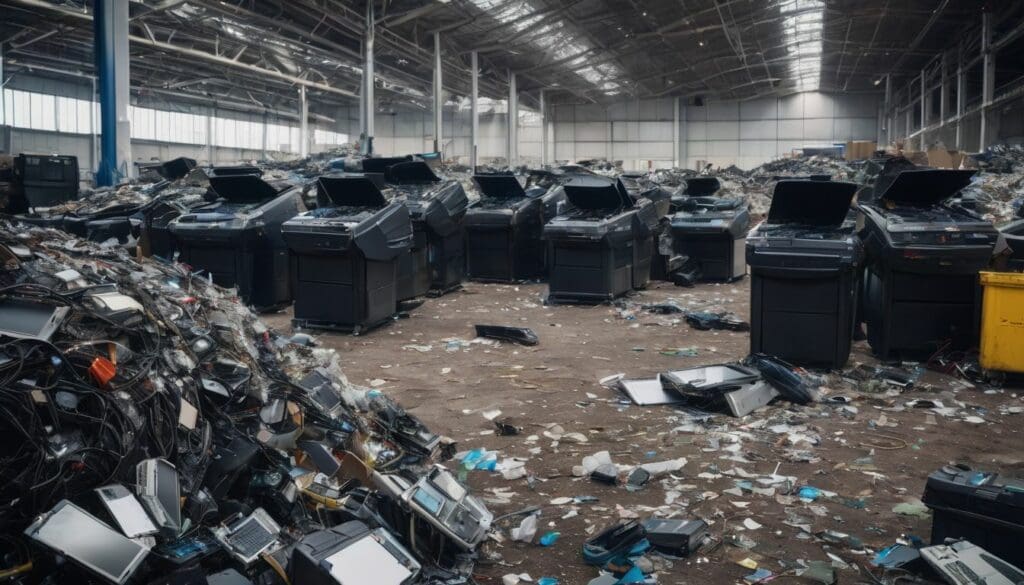The modern world thrives on consumption, but our planet pays the price. A staggering amount of waste ends up in landfills every year, with precious resources lost forever. It’s a cycle that seems unbreakable—but what if we could change it? My years working within sustainability sectors have shown me there is another way: the circular economy.
This approach doesn’t just patch up issues; it reinvents the very system by which we operate.
Embracing a closed-loop model turns ‘waste’ into an outdated term. Businesses worldwide are waking up to this reality, forging paths towards longevity and responsibility where resourcefulness is key.
Every step taken is a stride away from depletion and towards renewal—a vision proven possible through dynamic corporate action you’re about to uncover here. Let us delve into this transformative trend – your guide to a future without waste starts now!
Key Takeaways
- Companies like Nike, Ikea, and H&M are pioneering circular economy models by using closed-loop systems to minimise waste and use resources more sustainably.
- Circular economy practices lead to environmental benefits and economic gains by keeping products and materials in circulation for longer, reducing the need for new resources.
- Governments and regulators can support the shift towards a circular economy with policies that foster eco-friendly business practices, while consumer awareness is key to driving demand for sustainable products.
- Innovative approaches within companies involve designing products for longevity, prioritising resource efficiency, and embracing recycling initiatives to achieve zero-waste operations.
- The closed – loop model represents a transformative approach where businesses no longer view waste as an endpoint but as a resource that can be continuously reused or repurposed.
Understanding the Circular Economy
The circular economy is a sustainable business model that focuses on resource efficiency, waste minimisation, and the use of recycled and reusable materials. Embracing circular economy practices can lead to long-term environmental stewardship and create new opportunities for businesses.
Definition and Importance
A circular economy redefines the traditional ‘take-make-dispose’ model by keeping resources in use for as long as possible. This sustainable business model aims to eliminate waste entirely, opting instead for a regenerative approach where products are designed and built to last, be repaired or easily recycled.
Closed-loop systems drive this economy, pushing industries towards more eco-friendly practices that prioritise resource efficiency and environmental stewardship.
Embracing these principles holds immense importance for our planet’s future. Companies adopting a circular supply chain contribute significantly to waste reduction and resource conservation.
By minimising reliance on new materials and fostering renewable resources, businesses can create long-term value not just economically but also environmentally. This shift not only helps protect natural ecosystems but it also offers companies a competitive edge in an increasingly resource-constrained world – making it clear that what’s good for the earth is good for business too.
Benefits of Embracing Circular Economy Practices
Embracing circular economy practices brings numerous benefits, including waste minimisation and the use of recycled materials. By adopting a closed-loop system, companies can create long-term value while promoting environmental sustainability.
This approach allows for zero-waste initiatives, prioritising sustainable business practices that contribute to eco-friendly waste management and green technology.
Companies embracing the closed-loop model are contributing to industrial ecology by minimising waste and maximising the value of resources. Through zerowaste manufacturing and a focus on sustainable business practices, these companies are demonstrating how the circular economy promotes a more sustainable future with innovative approaches to recycling.
Examples of Circular Companies
Nike’s Move To Zero Programme, Ikea’s Circular Business Model, H&M’s Four Steps to Circular, HP’s Circular Economy initiatives, Adidas’ commitment to sustainability, Patagonia’s dedication to reuse and recycling, and Siemens’ focus on sustainability all serve as inspiring examples of companies embracing the circular economy model.
Nike’s Move To Zero Programme
Nike’s Move to Zero Programme is a pioneering initiative that aligns with the circular economy model. By prioritising sustainability and eco-friendly practices, Nike is committed to minimising waste through its closed-loop manufacturing processes.
Embracing zero-waste initiatives, the programme focuses on using recycled materials and implementing innovative approaches to ensure long-term value in their products.
Nike’s Move to Zero Programme supports conservation efforts by rethinking how resources are utilised and promoting sustainable resource use. This forward-thinking approach contributes significantly towards achieving a zero-waste system while emphasising the importance of eco-friendly practices in the manufacturing industry.
Ikea’s Circular Business Model
Ikea’s circular business model focuses on creating a closed-loop system within its operations to reduce waste and promote sustainable resource use. The company has made significant strides in implementing zero-waste initiatives, incorporating eco-friendly practices, and embracing closed-loop manufacturing processes using recycled materials.
By prioritising sustainability and adopting innovative approaches to the circular economy, Ikea is actively contributing to the advancement of a zero-waste future.
Next, let’s explore H&M’s Four Steps to Circular.
H&M’s Four Steps to Circular
Transitioning from Ikea’s Circular Business Model, H&M has embraced a circular economy through progressive initiatives. The company’s four steps to circular sustainability involve collecting and recycling used garments, using sustainable materials in their designs, offering repair services, and promoting the prolongation of clothing lifespan.
These strategic actions contribute to minimising waste and maximising the value of resources within the fashion industry. By prioritising eco-friendly practices and zero-waste initiatives, H&M underscores its commitment to conservation while actively engaging environmentally conscious individuals who value long-term environmental impact.
Circular Economy at HP
HP actively embraces the circular economy by prioritising sustainability and implementing closed-loop manufacturing processes. The company focuses on long-term value, incorporating zero-waste initiatives and eco-friendly practices into its operations.
HP’s commitment to a closed-loop system allows for more with less, keeping products, components, and materials at their highest utility and value through innovative approaches to circular economy models.
Implementing recycled materials in its supply chains, HP contributes to the advancement of the circular economy by eliminating waste and promoting sustainable resource use. By embracing a zero-waste future, HP demonstrates the benefits of reducing waste and reusing resources within a circular economic model.
Prioritising Sustainability at Adidas
Transitioning from the innovative circular economy practices at HP to prioritising sustainability at Adidas, it’s evident that leading brands are embracing eco-friendly initiatives.
Adidas has committed to achieving a closed-loop system with its products, emphasising zero-waste initiatives and long-term value. By incorporating sustainable materials and production processes into their supply chain, Adidas actively contributes to reducing waste and promoting conservation efforts.
The brand’s dedication to rethinking how they produce and consume aligns with the core principles of the circular economy, contributing significantly to environmental stewardship.
Adidas’ approach involves embracing closed-loop manufacturing using recycled materials, aiming to eliminate waste while sustaining a continuous flow of resources. This commitment not only supports conservation but also serves as an example for other companies looking towards sustainable business models.
Patagonia’s Commitment to Reuse, Repair, and Recycling
Transitioning from prioritising sustainability at Adidas, another leading company dedicated to environmental stewardship is Patagonia. Patagonia has established a robust commitment to reuse, repair, and recycling as part of its circular economy initiatives.
The company actively encourages the extension of product lifecycles through repair services and the promotion of second-hand merchandise. By incorporating recycled materials into their products, Patagonia minimises waste and contributes to sustainable resource use within their supply chain.
Additionally, the brand’s Worn Wear programme promotes a culture of reusing and repairing clothing, further exemplifying its dedication to reducing environmental impact.
Patagonia’s approach aligns with the principles of a closed-loop system by minimising waste through promoting reuse and repair and integrating eco-friendly practices into its manufacturing processes.
Siemens’s Commitment to Sustainability
Siemens demonstrates a strong commitment to sustainability through its adoption of circular economy principles. The company actively implements closed-loop systems and zero-waste initiatives, contributing to the advancement of sustainable practices in manufacturing and beyond.
By prioritising eco-friendly practices and embracing closed-loop manufacturing processes using recycled materials, Siemens sets an example for other companies looking to reduce waste and maximise the value of resources.
Siemens’ dedication to sustainability underscores the importance of prioritising environmental conservation while maintaining long-term value in business operations. Through their ongoing efforts, Siemens is creating a positive impact on the environment and setting a precedent for others in the industry.
The Process of Becoming A Circular Company
Implementing a circular economy model involves focusing on key pillars such as design for longevity, resource efficiency, and waste reduction. Discover how businesses are embracing these practices to reduce their environmental impact and create long-term value.
Read more about the innovative approaches to circular economy models in our blog!
Key Pillars of the Circular Economy
- Closed-loop systems: In the circular economy, closed-loop systems aim to keep products, components, and materials at their highest utility and value, allowing for more with less.
- Sustainable resource use: Embracing the circular economy means prioritising sustainable resource use by ensuring that materials are always in flow, requiring fewer resources overall.
- Waste reduction: This model eliminates the concept of waste by rethinking how we produce and consume goods, moving towards a zero-waste system through innovative approaches such as closed-loop manufacturing using recycled materials.
- Promoting longevity: Circular economy models promote longevity by encouraging companies to adopt practices that recover and reuse materials, thereby contributing to a zero-waste future.
- Embracing innovation: Companies embracing the circular economy demonstrate commitment to advancements in sustainable resource use, setting an example for others regarding the benefits of reducing waste and reusing resources.
- Economic sustainability: The circular economy aims to create economic sustainability through closed-loop systems that prioritise longevity and value of resources while reducing waste.
Importance of Circular Economy Models
Transitioning from understanding the key pillars of the circular economy to recognising the importance of circular economy models, it becomes evident that embracing this model is crucial for achieving sustainable resource use and reducing waste.
Companies adopting closed-loop systems contribute significantly to environmental conservation by keeping resources in circulation and minimising their negative impact on the environment.
This approach not only supports zero-waste initiatives but also promotes eco-friendly practices throughout the production and consumption cycles.
Innovative Approaches to Circular Economy Models
Transitioning from the importance of circular economy models to innovative approaches, it’s essential to highlight how companies are actively embracing closed-loop manufacturing and zero-waste initiatives.
By adopting advanced technology and materials recovery processes, companies are creating eco-friendly practices that drive the transformation towards a sustainable circular economy.
These innovative approaches integrate long-term value into product design, supply chain management, and waste reduction strategies.
Companies implementing innovative circular economy models strive towards closed-loop systems while prioritising sustainability at every stage. They are pioneering new methods for reusing resources, eliminating waste in production processes, and engineering products with longevity in mind.
Trends and Predictions for Circular Companies
As the circular economy gains momentum, governments and regulators are expected to play a crucial role in shaping policies to support and incentivise circular practices. Additionally, consumer awareness and education will become increasingly important in driving demand for sustainable products and encouraging companies to embrace closed-loop models.
The Role of Governments and Regulators
Governments and regulators play a crucial role in advancing the circular economy by implementing policies that support eco-friendly practices and zero-waste initiatives. They can encourage companies to embrace closed-loop manufacturing and long-term value through regulations that promote sustainable resource use.
Additionally, they can provide incentives for businesses to prioritise sustainability, fostering a conducive environment for circular economy models. By creating a supportive regulatory framework, governments and regulators empower companies to adopt environmentally friendly practices and contribute to the movement towards a zero-waste future.
Furthermore, governments have the power to raise awareness about the importance of embracing circular economy practices among consumers. Through education initiatives, they can inform individuals about the benefits of closed-loop systems and how they contribute to conservation efforts.
The Importance of Consumer Awareness and Education
With the closed-loop model gaining momentum, consumer awareness and education play a crucial role in driving sustainable practices. Consumer understanding of circular economy principles empowers individuals to make informed purchasing decisions that support brands embracing eco-friendly practices.
By being aware of the impact of their choices, environmentally conscious consumers can drive demand for products made from recycled materials and those designed with future use and recyclability in mind.
Education on zero-waste initiatives fosters a mindset shift towards reducing consumption and reusing resources, aligning with the long-term value offered by circular economy models.
Empowering consumers through education about the benefits of closed-loop manufacturing and zero-waste initiatives creates a ripple effect in environmental conservation efforts. With heightened awareness, individuals actively seek out brands prioritising sustainability, encouraging market competition towards more eco-friendly business practices.
Conclusion: Embracing a Zero-Waste Future Through Circular Economy Practices in Business and Everyday Life
Embracing a zero-waste future through circular economy practices is crucial for sustainable business and everyday life. Companies actively implementing closed-loop systems minimise waste and maximise the value of resources.
By adopting eco-friendly practices, companies contribute to reducing waste and promoting sustainable resource use. Embracing the closed-loop model not only benefits businesses but also supports conservation and environmental goals.
This approach paves the way for a more efficient, environmentally friendly future.
FAQs
1. What is a closed-loop system in the circular economy?
A closed-loop system is an eco-friendly practice where companies make products meant to be reused, repaired or recycled, aiming for zero waste and long-term value.
2. How does closed-loop manufacturing work?
In closed-loop manufacturing, everything a company produces or uses comes back into the business cycle instead of becoming waste, creating a more sustainable way to operate.
3. Can embracing the closed-loop model really add long-term value to businesses?
Yes! Companies that embrace this model can save money on raw materials and build brand loyalty through their zero-waste initiatives and commitment to reducing environmental impact.
4. Are there any real-world examples of zero-waste initiatives by companies?
Many businesses nowadays implement zero-waste initiatives by recycling materials, using biodegradable packaging or designing products for easy disassembly at end-of-life.





